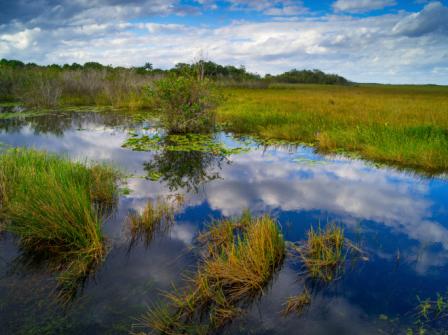Southwest Florida Assesses Salt Marsh Vulnerability to Sea Level Rise
 Salt marshes are vitally important to Southwest Florida. They serve as storm surge buffers, shoreline stabilizers and breeding grounds for wildlife. The 2014 National Climate Assessment projects that salt marshes are at risk both in Florida and around the country from anticipated climate impacts including relative sea level rise, coastal erosion, and more intense storms. The Charlotte Harbor National Estuary Program and Southwest Florida Regional Planning Commission, supported by an EPA assistance grant, collaborated to assess the historic and current range of salt marshes in this region, and identify their vulnerability to changing climate conditions.
Salt marshes are vitally important to Southwest Florida. They serve as storm surge buffers, shoreline stabilizers and breeding grounds for wildlife. The 2014 National Climate Assessment projects that salt marshes are at risk both in Florida and around the country from anticipated climate impacts including relative sea level rise, coastal erosion, and more intense storms. The Charlotte Harbor National Estuary Program and Southwest Florida Regional Planning Commission, supported by an EPA assistance grant, collaborated to assess the historic and current range of salt marshes in this region, and identify their vulnerability to changing climate conditions.
The Climate Change Vulnerability Assessment and Adaptation Opportunities for Salt Marsh Types in Southwest Florida study determined that the current pace of sea level rise appears to allow some locations for marsh migration on mainland shores, however “in other locations salt marshes are drowning where there is no location to move to.” The study further mapped these areas to better determine the barriers to movement and understand where salt marshes are able to, and in the future expected to, move as they adapt to higher sea levels. By providing information on expected migration and isolation areas, the report helps local governments identify priority conservation areas to preserve salt marshes and their associated benefits under current and future conditions. The study included recommendations that governments, stakeholder groups or the public could take as part of their adaptation strategies (e.g., protecting or armoring of shorelines).
| How Did They Do It? | Applicable EPA Tools |
|---|---|
|
Identified climate vulnerability to salt marsh wetlands
|
Being Prepared For Climate Change Workbook helps develop a risk-based climate change adaptation plan consisting of a vulnerability assessment and an action plan to reduce the most pressing coastal risks. |
Developed actionable adaptation recommendations
|
Synthesis of Adaptation Options for Coastal Areas Guidebook helps identify climate risks to coastal ecosystems and review adaptation options available to coastal managers. The Rolling Easements Primer provides a more in-depth review of a adaptation option applicable to protecting coastal marshes. |
Similar Cases and More Information
To see another example of how a coastal community assessed their vulnerability view the San Juan Estuary Programs Vulnerability Assessment Case or the Southeast Florida Climate Compact. Many coastal communities in the southeast may have to account for other climate vulnerabilities, such as threats to drinking and wastewater services. Saltwater intrusion, sea level rise and more intense hurricanes can threaten coastal infrastructure. To learn more about how another southeastern community adapted to saltwater intrusion and potential water quantity considerations see how Tampa Bay Water diversified their source water to promote resiliency to current and future conditions.
- San Juan Estuary Programs Vulnerability Assessment Case
- Southeast Florida Climate Compact
- Tampa Bay Water

